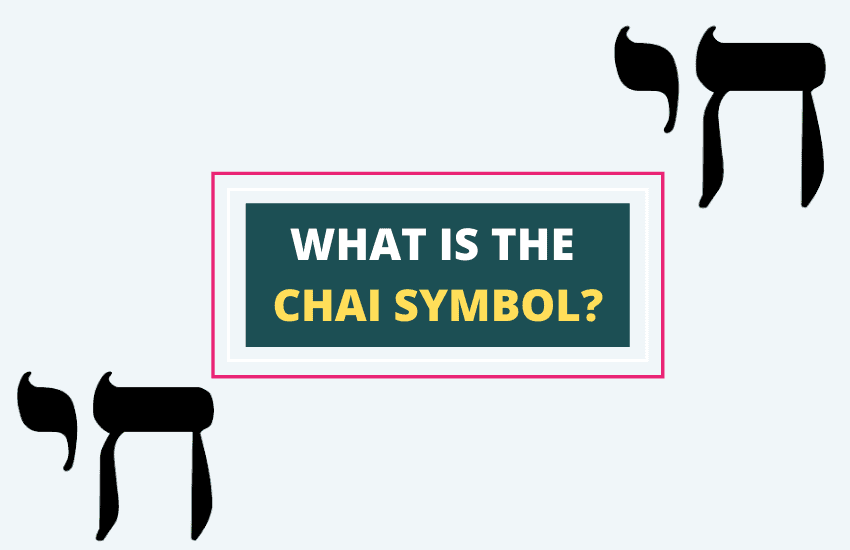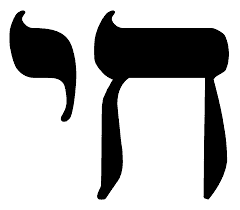
Table of Contents
One of the most prominent emblems in the Jewish culture, the Chai symbol is composed of written Hebrew letters forming the word chai. Let’s take a look at how this name became associated with numerology and a toasting ritual, along with its symbolic meanings and uses today.
History of the Chai Symbol

Usually pronounced with a kh sound, chai is a Hebrew word that means life, alive or living. Sometimes, it’s referred to in the plural form chaim. The symbol is composed of two Hebrew letters, chet (ח) and yud (י). As far back as the earliest Jewish roots, the letters were used as symbols in their faith. Even if it has ancient origins, it didn’t become associated with the Jewish culture until the 20th century.
The Chai Symbol in Jewish Culture
The protection of life is regarded as one of the main principles of Judaism. As such, the chai symbol can be found everywhere in Jewish contexts, from Jewish architecture to paintings, jewelry and other sacred objects. However, its use as a visual sign can be traced back to medieval Spain. The symbol was also worn as an amulet during the 18th century in Eastern Europe.
The symbol is commonly seen inscribed on mezuzot, a small decorative case holding a rolled parchment with sacred texts, placed on doorframes or hung in the hallways of buildings. Since the piece carries the sacred symbol, it’s believed to separate the sacred space one’s home and the ungodly outside world.
The Word Chai and the Toasting Ritual
Many scholars say that the practice of toasting developed from religious rituals that involve offering wine or blood to gods, along with prayers to seek blessings, health and long life. Others believe it originated out of a fear of poisoning. In Jewish culture, the toast for alcoholic beverages is called l’chaim, which comes from the word chai and translates as to life.
For the Jewish community, the sacred word resonates with their petition to their god for granting their pleas, especially during feasts. Most of the time, it’s done during weddings, Jewish New Year or Rosh Hashanah, as well as coming of age rituals for boys and girls, known as the bar mitzvah and bat mitzvah respectively. The word chai is commonly said during the Yom Kippur, which is the holy day of atonement and repentance for the Jewish people.
The Phrase Am Yisrael Chai!
In 1942, the Nazi Germany led by Adolf Hitler planned the destruction of Jewish people in Europe, more commonly known as the Holocaust. The popular Jewish phrase Am Yisrael Chai (עַם יִשְׂרָאֵל חַי) translates as The people of Israel live. It’s commonly used as a declaration for the survival of the Jewish people and Israel as a nation, as well as a prayer of sort.
In Hebrew Numerology
In divine mathematics called gematria, the letters in the Hebrew alphabet have corresponding numerical values, which are associated with sacred concepts. It’s believed that the practice can be traced back to around the 8th century B.C.E. in Mesopotamia, but the study only began between 10 and 220 C.E. during the Mishnaic Period.
The chai symbol has a value of 18—consisting of chet with the value of 8, and yud with the value of 10—that is seen as sacred in Jewish culture. Chai is linked to texts of the Kabbalah, the school of Jewish mysticism, and also appears several times in the Bible.
Meaning of the Chai Symbol
It’s no doubt that the symbol is significant to Jewish faith and culture. Here are some of its meanings.
- A Symbol of Life – It represents the importance of life and serves as a reminder to live and protect life. It can also mean that God is perfectly alive, and His believers are spiritually alive.
The significance of chai is evident in Jewish law, in which life is more important than following strict commandments and traditions. For instance, medical professionals are allowed to answer medical calls and save lives during their Sabbath, while the rest must refrain from work. Also, the elderly and pregnant women are not supposed to fast on the occasion of Yom Kippur or the Day of Atonement.
- Chet is the 8th letter of the Hebrew alphabetthat is also associated with the ritual of circumcision, which is often done on the eighth day of a child’s life.
- Yud is the 10th letter and the smallest letter of the Hebrew alphabet, making it associated with humility. It also means hand or arm, which is why the letter is modeled after a hand.
- A Symbol of Good Luck – Based on the gematria, the symbol has the value of 18, which is seen as a good omen. In Jewish circles, the tradition of giving gifts of money, donations, or charitable contributions in multiples of chai such as 18, 36, 54 and so on is considered good luck and is referred to as giving Chai. The number 36 is regarded as the double chai.
Below is a list of the editor’s top picks featuring chai symbol necklace.
The Chai Symbol in the Modern Times
The chai symbol can be commonly seen on Jewish architecture, sculptures, paintings, and even in fashion and jewelry pieces. In fact, the chai symbol is often worn in the form of necklace pendants, medallion, amulets, bracelets, or rings. Sometimes, it even comes with other popular symbols such as the Star of David, or the Hamsa Hand.
The mezuzah or mezuzot with the inscription of chai are still a common home decoration. Many modern items are adorned with the symbol including t-shirts, shawls and mugs. In pop culture, the symbolism of chai and the toast of l’chaim was featured in the American epic musical film Fiddler on the Roof in 1971.
In Brief
As a symbol of life, the Chai remains a representation of Jewish belief and culture, making it one of the most sacred symbols of the religion, and a popular motif in various works of art.











